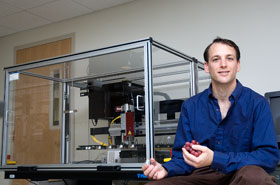  |
| HOME | THIS ISSUE | CALENDAR | GRANTS | BACK ISSUES | < BACK | NEXT > |
Strains of yeast may determine taste of wine, biologist findsby Cindy Weiss - September 26, 2005 |
||||
|
A question dating back to the days of scientist Louis Pasteur intrigued a young professor in the Department of Molecular and Cell Biology, leading to new findings about yeasts and their potentially large role in determining the taste of wine. Jeffrey Townsend, who joined the biology faculty in the College of Liberal Arts and Sciences a year ago, studies both bread and wine yeasts as part of his research into population genetics. He was not satisfied with the popular belief that the yeast which causes fermentation comes from wine vats rather than from the vineyard. The question of where the wine yeast comes from dates back at least to Pasteur, he notes, who found that if the surfaces of grapes were washed before they were crushed, the fruit did not ferment. But when the substances that were washed off were added back into the mix, the grapes fermented. When the surfaces of the grapes were examined, however, other fungi – but not wine yeast – were found, leading to the conclusion that the wine yeast comes from the vats. “This strikes me as a very bizarre explanation,” Townsend says. His research, reported this summer in the journal Science, adds new knowledge of the diversity of types of yeast. In 2004, Science noted, a University of Pennsylvania scientist found the wine yeast Saccharomyces cerevisiae below the bark and at the base of oak trees in that state, and questions were raised about how many strains of wine yeast there are and how they are related to each other. Townsend and his colleagues have found distinct strains of the wine yeast in forests and vineyards in Italy and in California, where he was a postdoctoral Miller Research Fellow at the University of California at Berkeley. Now he is interested in finding out whether the population of yeast in California is the same as that in Italy or France. Indications are that the yeast has a large number of strains. “It may be resident yeasts that play a large role in determining the taste of wine,” Townsend says. The Pennsylvania wine yeasts were all more closely related to each other than to the yeasts Townsend collected in Italy. The yeasts even show variation from vineyard to vineyard. While this may be interesting from a wine lover’s perspective, it also demonstrates wide genetic diversity in the population of the wine yeast and is of interest to those studying the evolution of yeasts. Townsend examined the genes in the yeasts, looking for similarities in gene sequences to determine whether strains of the yeast are related to each other and looking for variation in gene expression. Understanding how the strains of wine yeast differ may help scientists understand how wines that are produced by natural fermentation vary in taste, he says.
For that reason, he looks to the vineyards of Europe, where natural fermentation, without added wine yeast, is more prevalent. In the United States, almost all fermentation is supplemented by what he calls “industrial strains” of yeast that will produce a marketable wine. S. cerevisiae is a good yeast to study as a model, he says, because it can grow and be stored easily in a laboratory and it lends itself to genetic study and to the use of microarrays, a technique developed about five years ago that allows scientists to look at an organism’s metabolism and function, simultaneously examining the gene expression level of every gene in the genome. This could help biologists find out how organisms survive and evolve, and Townsend, who has a strong quantitative background, wanted to apply the technique in his research. He developed his own microarray analysis method. A large part of his work, including research funded by the National Institutes of Health, involves statistical methods for studying DNA microarrays. The software he developed to do this – named “BAGEL” (Bayesian Analysis of Gene Expression Levels) – is now being used by other researchers. Townsend is also interested in horizontal gene transfer, studying the ways some DNA has transferred between divergent organisms, a phenomenon that is challenging the prevailing theories of how species evolve, with genes passing “vertically” from parents to offspring. A native of New Hampshire, Townsend earned his Ph.D. at Harvard. He and his wife, Alison Galvani, who was also a Miller Fellow at Berkeley, were pleased to return to New England; she is an assistant professor at the Yale School of Public Health’s Division of Epidemiology of Microbial Diseases. Their résumés added parallel lines again this summer, when they became two of the three national award winners of the American Society of Naturalists’ Young Investigator Prize. The society did not realize that they were spouses, he says, until after the winners were announced. |
| ADVANCE HOME UCONN HOME |

